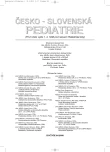Standards of the Multidisciplinary Treatment of a Child with Orofacial Cleft
Authors:
Z. Dvořák 1,2; J. Veselý 1,2; E. Konvičková 1; T. Výška 1; T. Mrázek 1; L. Kučerová 1; I. Halačková 1
Authors‘ workplace:
Klinika plastické a estetické chirurgie FN U sv. Anny, Brno
přednosta prof. MUDr. J. Veselý, CSc.
1; Lékařská fakulta Masarykovy Univerzity, Brno
2
Published in:
Čes-slov Pediat 2009; 64 (5): 236-241.
Category:
Review Article
Overview
The orofacial clefts are the most frequent congenital head and neck malformations. In a chart of the most frequent developmental defects they are placed on 2nd to 4th position. Worldwide the treatment of children with cleft lip and palate is concentrated in cleft centres and is carried out by a range of specialists. Multidisciplinary team of specialities involved with the treatment of clefts include plastic and maxillofacial surgery, orthodontics, prosthetics, pediatric dentistry, paediatrics, speech – language pathology, otolaryngology, genetics and psychology.
Basic requirements of the multidisciplinary care are defined in two documents, namely in Standards of Care for Cleft Lip and Palate in Europe that arose from The Eurocleft project – European-wide intercentric study and further from the instructions of the American Cleft Palate – Craniofacial Association (ACPA). By integration of both documents it is possible to determine the health care principles of children with orofacial clefts.
Key words:
orofacial cleft, cleft lip and palate, multidisciplinary treatment, Eurocleft project, ACPA
Sources
1. World Health Organization, Human Genetics Programme. World Atlas of Birth Defects. 1st ed. International Centre for Birth Defects of the International Clearinghouse for Birth Defects Monitoring Systems in collaboration with European Registration of Congenital Anomalies (EUROCAT), 1998.
2. Wornom IL, et al. Core curriculum for cleft lip/palate and other craniofacial anomalies. In: Berkowitz S. (ed). Cleft Lip and Palate. 2nd ed. Ch. 12. Berlin: Springer-Verlag Berlin Heidelberg, 2006: 283–300.
3. Dušková M. Úloha centra pro léčbu rozštěpových vad. In: Dušková M, et al. (eds). Pokroky v sekudární léčbě nemocných s rozštěpem. Hradec Králové: Olga Čermáková, nakladatelství, 2007: 169–173.
4. Shaw WC, Semb G, Nelson P, Brattstrom V, Moised K, Prahl-Andersen B, Gundlach KKH. The Eurocleft Project 1996–2000: overview. J. Cran. Maxillofac. Surg. 2001;29(3): 131–140.
5. Parameters for Evaluation and Treatment of Patients with Cleft Lip/Palate or Other Craniofacial Anomalies – Summary of Recommendations. American Cleft Palate-Craniofacial Association, May, 1993, Rev. 2007. In: http://www.acpa-cpf.org/teamcare/.
6. Carinci F, Pezzetti F, Scapoli L, et al. Genetics of nonsyndromic cleft lip and palate: a review of international studies and data regarding the Italian population. Cleft Palate Craniofac. J. 2000;37(1): 33–40.
7. Jones MC. Facial clefting. Etiology and developmental pathogenesis. Clin. Plast. Surg. 1993;20(4): 599–606.
8. Kaněrová H. Otázka primární prevence rozštěpových vad obličeje. Diplomová práce na UK 3. LF. Praha, 2006.
9. Christensen K, Fogh-Anderson P. Etiological subgroups in non-syndromic isolated cleft palate. A genetic-epidemiological study of 52 Danish birth cohorts. Clin. Genet. 1994;46: 329–335.
10. Paradise JL, Bluestone CD, Felder H. The universality of otitis media in 50 infants with cleft palate. Pediatrics 1969;44: 35–42.
11. Yules RB. Current concepts of treatment of ear disease in cleft palate children and adults. Cleft Palate Craniofac. J. 1975;12: 315–322.
12. Broen PA, Moller KT, Carlstrom J, et al. Comparison of the hearing histories of children with and without cleft palate. Cleft Palate Craniofac. J. 1996;33: 127–133.
13. McWilliams BJ, et al. A comparative study of four methods of evaluating velopharyngeal adequacy. Plast. Reconstr. Surg. 1981;68: 1–10.
14. Černý L, Fišer J. Foniatrická péče. In: Dušková M, et al. (eds). Pokroky v sekundární léčbě nemocných s rozštěpem. Hradec Králové: Olga Čermáková, nakladatelství, 2007: 145–149.
15. Stephens P, Saunders P, Bingham R. Neonatal cleft lip repair: a retrospective review of anaesthetic complications. Paediat. Anaesth. 1997;7: 33–36.
16. Randall P. A triangular flap operation for the primary repair of unilateral clefts of the lip. Plast. Reconstr. Surg. 1959;23: 331–347.
17. Millard DR, Jr. A primary camouflage of the unilateral harelook. In: Skoog T. (ed). Transactions of the First International Congress of Plastic Surgery. Baltimore: Williams & Wilkins, 1957: 160–166.
18. Furlow LT, Jr. Cleft palate repair by double opposing Zplasty. Plast. Reconstr. Surg. 1986;78: 724–738.
19. Csemy L, Dušková M. Psychologické faktory ovlivňující kvalitu živata a sociální adaptaci u adolescentů a mladých dospělých s vrozenou obličejovou vadou. Praha: Průběžná zpráva GAČR 406/06/1867, 2006.
20. Grayson BH, Cutting CB. Presurgical nasoalveolar orthopedic molding in primary correction of the nose, lip, and alveolous of infants born with unilateral and bilateral clefts. Cleft Palate Craniofac. J. 2001;38: 193–198.
Labels
Neonatology Paediatrics General practitioner for children and adolescentsArticle was published in
Czech-Slovak Pediatrics

2009 Issue 5
Most read in this issue
- Recent Trends in Diagnosis of Fetal Alcohol Syndrome
- Acute Neuroborrelioses in Children
- Molecular Diagnostics of Hereditary Unconjugated Hyperbilirubinemias in Slovakia
- Standards of the Multidisciplinary Treatment of a Child with Orofacial Cleft
